The white British are set to become a minority around the middle of this century
An examination of census, school, and birth data
Britain is undergoing rapid demographic change. Given current birth rates and levels of immigration, the white British, the native ethnic group of this country, are set to become a minority within decades.
No major political party is talking about this, or is willing to openly state whether or not this would be an acceptable outcome. This is not some ‘conspiracy theory’. Nor is it mere hyperbole for the sake of clicks. It is a demographic reality that will materialise in the years and decades ahead if Britain continues on its current trajectory.
A note on the Boriswave
But first, before I go over the statistics, let’s discuss how we got to this situation in the first place. Demographic change in Britain is pretty much exclusively driven by immigration, a process that has been ongoing for many decades. However, immigration accelerated rapidly after Tony Blair won a landslide majority in 1997. This is detailed by the think tank Migration Watch UK:
In 1997 net migration was 48,000 however it rose extremely rapidly, almost trebling in one year to 140,000 in 1998; it was not to fall below 100,000 again. Between 1997 and 2010, the New Labour years, net migration averaged 200,000 per year, five times higher than under the Major government of 1990-1996.
It is now clear that net foreign migration between 1997 and 2010 was 3.6 million, while nearly a million British citizens emigrated giving total net migration of 2.7 million. The rate of inflow between 1997 and 2010 equated to one migrant arriving every minute.
But it would not be fair to purely attribute demographic change to Labour. The Conservatives, the party of government from 2010 to 2024, share much of the blame as well: despite pledging to bring net migration down to the ‘tens of thousands’ in their 2010, 2015, and 2017 manifestos, this promise was never kept. Much of the immigration into Britain thus occurred under their watch.
If we look at this graphic from Wikipedia, we can get a breakdown on the year of arrival for foreign-born residents in England and Wales, as per the 2021 Census:
Conservatives would probably argue that for much of this time, we were a member of the European Union; this meant that we had to accept freedom of movement, and that there was nothing much they could have done to bring down levels of immigration. This is a fair retort, but one that doesn’t excuse the post-2021 surge in immigration, which happened after we left the European Union and gained full control over immigration and border policy.
The massive wave of immigration after 2021 is commonly referred to as the ‘Boriswave’. This betrayal has greatly accelerated demographic change in Britain and, eventually, will cost the taxpayer hundreds of billions of pounds.
Before Brexit, non-EEA workers were capped and had to have a salary of £35,800 or higher to settle in the UK. However, from December 2020, when everyone was preoccupied with COVID-19, vaccines, and lockdowns, and just before the transitional period was due to end, with Britain leaving the EU, the Single Market and the Customs Union, the Johnson Government reduced the salary threshold considerably. Now, non-EEA workers in certain occupations only needed to earn as little as £20,480 to settle here. Even at the time of writing, the salary threshold for the Skilled Worker visa sits at £38,700 — something that was (belatedly) brought in by the Sunak Government in April 2024, among other measures, such as restrictions on international students and care workers bringing dependents with them. But even the current salary threshold of £38,700 means that the threshold has not kept up with inflation: if it had, it would currently sit at £45,300.
This wasn’t the only sin of the Johnson Government on immigration. It also introduced the Health and Care visa. Given the circumstances, it received little scrutiny. Originally, it had no caps on the number of dependents a worker could bring with them; no maximum age on the worker applying; and didn’t even include proper vetting for employers who sponsored a worker on this visa, enabling widespread fraud. Even years later, politicians were left speechless when it was explained to them just how wide the scope of this visa was, as a clip from a Home Affairs Select Committee makes clear. A paper by the Centre for Policy Studies shows that between January 2021 and June 2024, nearly 650,000 people arrived via this visa alone; of these, around 375,000 (or 57%) were dependents.
Many Conservatives remain unrepentant. Priti Patel, the Home Secretary who oversaw the creation of the conditions that enabled the massive surge, had a truly disastrous exchange with Harry Cole from The Sun back in January in which she implied that Brexit was actually all about throwing open the borders to the rest of the world, and that these immigrants were actually ‘the brightest and the best’ — despite only 5% of visas issued between 2022 and 2023 going to migrants who are likely to be lifetime net fiscal contributors.
While most Conservatives will not go as far as Patel on this specific point, others will claim (as Patel also did in this interview) that the Boriswave was simply the result of people from Hong Kong and Ukraine arriving on humanitarian visa routes opened up due to special circumstances. This is untrue. As Aylmer illustrates, even if you subtract those who arrived under the Hong Kong BN(O) and Ukraine humanitarian visa schemes, the Boriswave is still huge; indeed, these schemes combined barely make a dent.
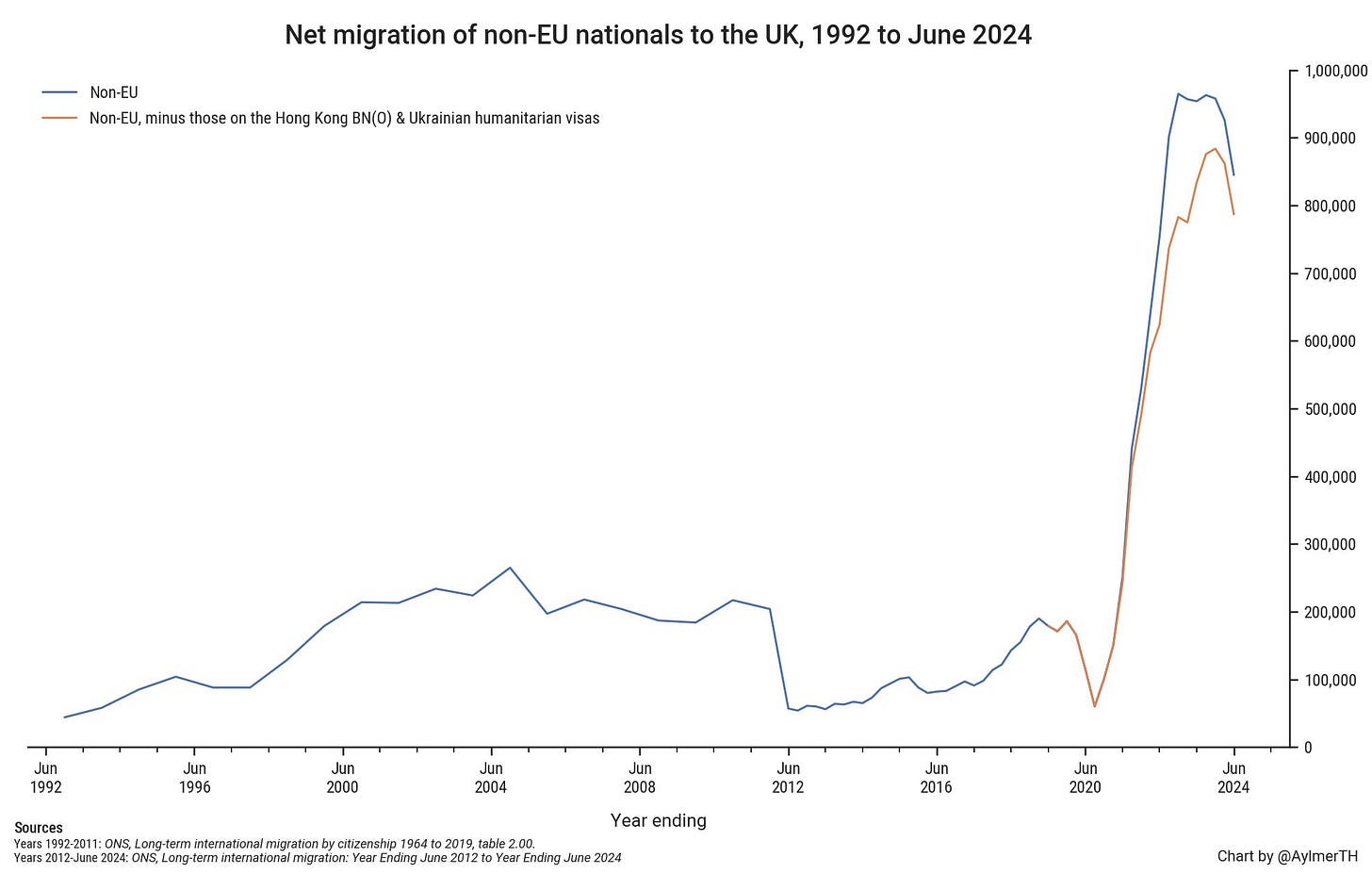
Since their defeat in July 2024, the Conservatives have announced some measures that, if enacted, would alleviate and potentially prevent some of the Boriswave settling here permanently. This includes increasing the qualifying period for Indefinite Leave to Remain (ILR) from five to ten years, plus an additional five year wait before applying for citizenship after obtaining ILR (rather than the current twelve-month wait). Anyone who has claimed benefits, used social housing, or has a criminal record will be banned from obtaining ILR. The Starmer Government’s recent White Paper, to my surprise, includes an increase in the qualifying period for ILR from five to ten years, at least for some migrants. While it has not yet been confirmed by Yvette Cooper, the Home Secretary, whether these changes will be applied retrospectively (i.e., to existing visa holders), BBC News, The Financial Times, and The Times are all reporting that the Government’s intention is to apply these conditions retrospectively, subject to a consultation later this year.
There remains some uncertainty around what percentage of the Boriswave will remain in the UK, and how many will apply for ILR or citizenship under the current rules. However, it’s worth noting that much of the Boriswave have come from Commonwealth countries like India, Pakistan, Nigeria, and Bangladesh, and so are eligible (under certain conditions) to vote in UK elections as ‘Commonwealth citizens’, even if they don’t have British citizenship.
If the changes to the rules on ILR eligibility aren’t applied retrospectively, then the Boriswave will start to become eligible for ILR after 2026. If an estimated 800,000 to 1,200,000 Boriswave immigrants obtain permanent residency, the same paper from the Centre for Policy Studies estimates that the lifetime net fiscal cost to the taxpayer will be £234 billion. This could help explain why the Government is now contemplating changing the rules: not only will it help reduce net migration, but it could also save the British taxpayer tens of billions of pounds in the years to come. Let’s hope that Labour end up applying these changes to existing visa-holders, and don’t end up watering their proposals down during the consultation stage (or due to the the courts ruling against them).
The reason that I have devoted so much space to the Boriswave is not to imply that demographic change began with the Johnson Government (although he accelerated things significantly). Nor is it to claim that Britain was an especially contented society in 2021, or that immigration hadn’t already caused severe social problems. It’s merely because much of the data I’m about to use only goes up to the 2021 Census, which was conducted before the Boriswave really began, and the next census isn’t due until 2031. All the data below is thus not only out of date, but missed the biggest wave of immigration in British history. While the Census Act of 1920 allows for a census to be called every five years, rather than the normal ten, it’s very unlikely that any Government will call for an early census which will inevitably expose further demographic change from immigration — something that the public have consistently voted against. In fact, far from an emergency census, there is actually talk that the ONS, permanently in crisis since its move to Newport, might cancel the 2031 Census altogether.
Census, schools, and births data
Now onto demographic change, as tracked by the census (with the caveats mentioned above). If we look at the data from the 1951 Census and 1971 Census, the United Kingdom was an overwhelmingly white country, with a very small ethnic minority population. Below is a GIF from Wikipedia which shows the change that has occurred from 1951 to 2021/2022. (The census for England, Wales and Northern Ireland took place in 2021, but the census for Scotland took place in 2022 — hence why it’s displayed as ‘2021/2022’.)
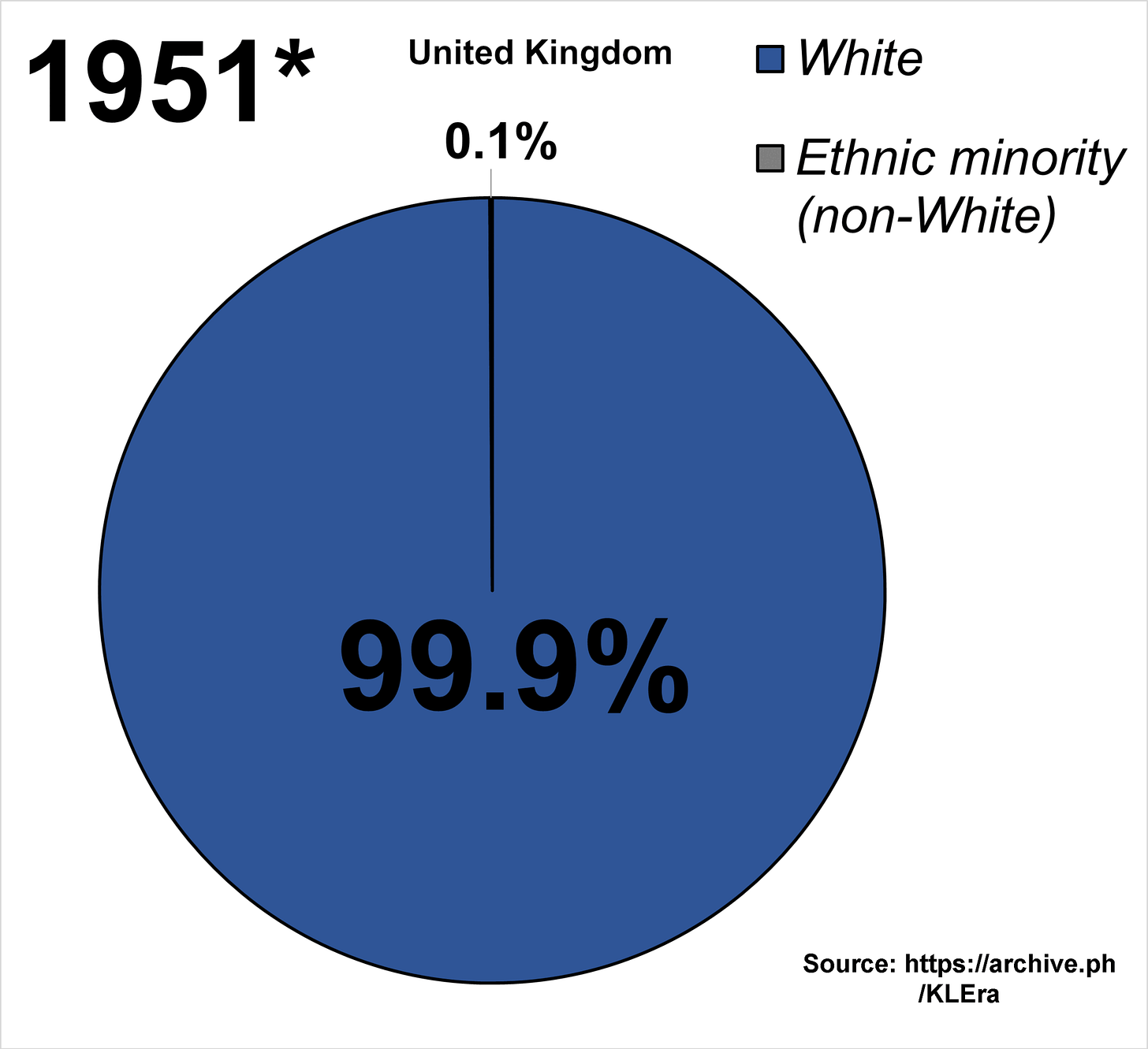
From the graphic above, it is clear that demographic change has accelerated rapidly since 2001. Between the 1951 Census and the 1991 Census, the percentage of the population that is white fell from 99.9% to 94.5%, a decline of 5.4 percentage points over a 40-year period. Yet, by the time of the 2001 Census, this percentage stood at 92.1%, falling further still to 83% at the time of the 2021/2022 Census — a decline of 9.1 percentage points over a twenty-year period, nearly twice the rate of demographic change over half the amount of time.
It’s also worth bearing in mind that Scotland, Wales, and Northern Ireland haven’t seen anywhere near as much immigration as England has. If we look at the graphic below, also from Wikipedia, which shows the ethnic breakdown of England from the 1981 Census to the 2021 Census, the change is even more rapid. The white percentage of the population declines from 95.4% in 1981 to 81% in 2021, or a decline of 14.4 percentage points over a 40-year period:
For the remainder of this article, I will focus on the decline of the ‘white British’ ethnic group. This is an ethnic category added in the 2001 Census, and is how the Office for National Statistics and other governmental departments and agencies refer to those who are white and who say they are English, Welsh, Scottish, Northern Irish or British; the group that you would accurately describe as the ‘native’ or ‘indigenous’ population of these Isles.
Demographic change is most noticeable of all in major urban areas like London, Birmingham, and Manchester. All three are now ‘majority-minority’ cities, with the white British population sitting at just 36.8% for London, 42.9% for Birmingham, and 48.7% for Manchester. And, to repeat ourselves: all of these figures are pre-Boriswave, and many of the white British people living in these places will be older.
The importance of this second fact is best demonstrated by looking at the ethnicity of school pupils in England, published every year by the Department of Education going back to the 2015/16 school year. We can see that demographic change is even more stark among younger cohorts. In London, we can see that for the 2023/24 school year, just 22.7% of pupils were white British, down from 27.4% in the 2015/16 school year:
The story is no different in Birmingham, which sat at 25% in 2023/24, down from 31.7% in 2015/16:
And finally, for Manchester, the figure is 30.1% in 2023/24, down from 38.8% in 2015/16:
It is true that if you look at places like Cornwall, the overwhelmingly majority of students are still white British, with little decline since 2015/16. Indeed, the figure has increased since 2018/19:
However, if you look at England as a whole, the trend is clear: white British students have been declining as a percentage of the younger cohorts — the demographic future of this country. Between the 2015/16 school year and the 2023/24 school year, the percentage of white British pupils fell from 69.3% to 61.3%, a decline of 8 percentage points over this period:
We also have another vector by which we can gauge upcoming demographic changes. Every year, the Office for National Statistics releases data on the ethnicity of births in England and Wales. The data covering 2007 to 2022 can be found here in the ‘birth characteristics’ document, and the data covering 2023 can be found here in the linked births document. Below, I’ve created a chart plotting the percentage of white British births in England and Wales from 2007 to 2023:
You may notice the clear acceleration of the trend in the last few years, from 2021 to 2023. In this period, white British births have fallen from 58.85% to 55.56%, or a decline of 3.29 percentage points in just two years. Is this the Boriswave starting to seep through?
The ONS also publishes quarterly provisional data on births in England and Wales. The most recent release covers January to September 2024, though there are a few caveats:
This data doesn’t cover the full year, and the figures could be revised up or down in the full release.
The provisional Welsh data also puts all white births under ‘white’, with no distinction between ‘white British’ and ‘white other’ births.
As a result, in the data below I have assumed that all the births listed as ‘white’ in Wales are ‘white British’. (In the 2023 data, only 564 births in Wales were recorded in the ‘white other’ category. This is insignificant in the overall figure.)
Below, I have updated the chart and included the provisional figures for England and Wales for the first nine months of 2024:
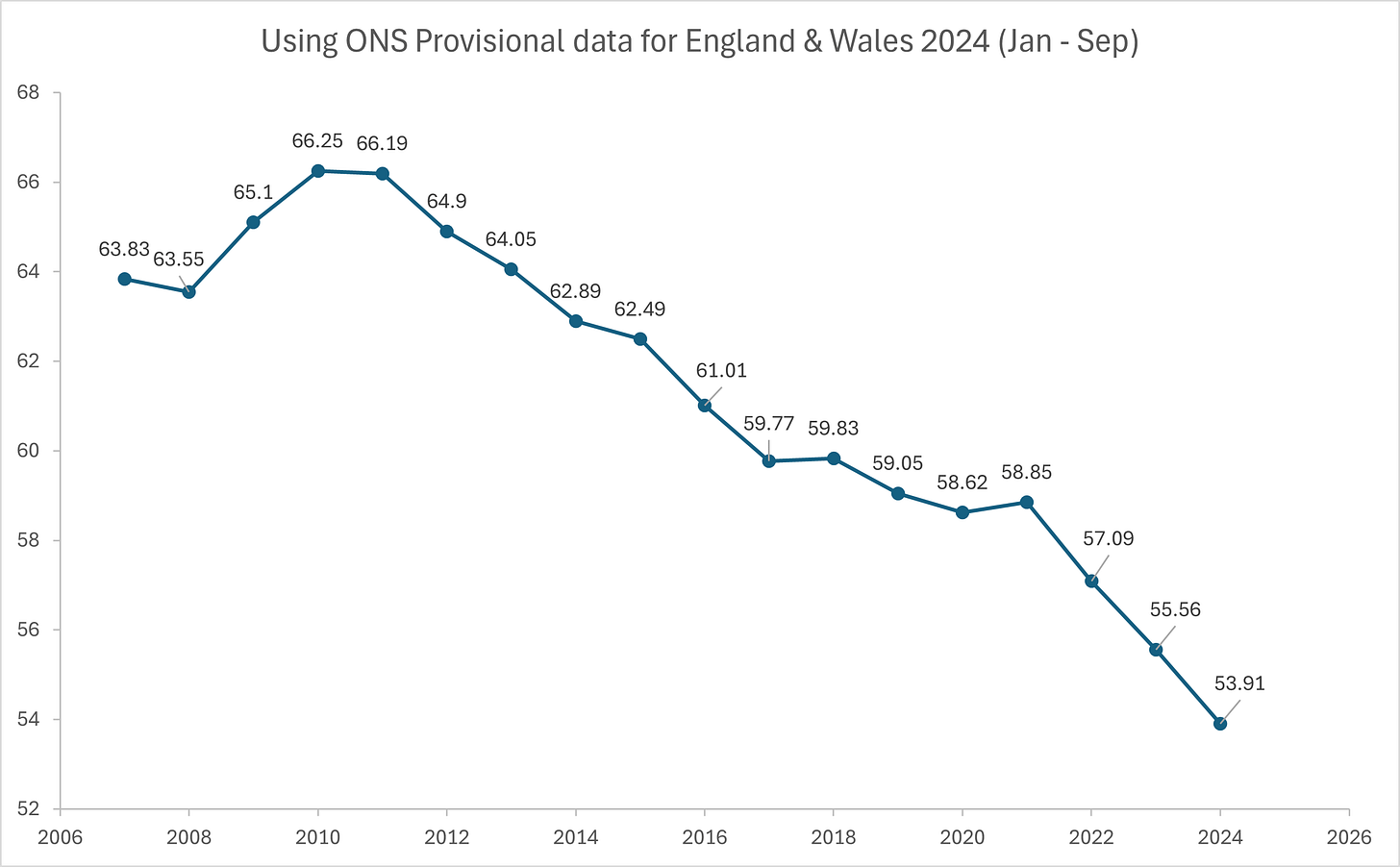
As you can see, from 2021, the decline of white British births has accelerated rapidly. If these trends continue, it’s pretty much a certainty that white British births will fall below 50% in England and Wales and, not long after, white British pupils will become a minority in schools. It’s worth bearing in mind that the census is a lagging indicator. Whilst the 2021 Census recorded that 74.4% of the population of England and Wales was white British, much of this cohort will be older people. Many of them will be in care homes, or retired; you won’t see these people at work or on your daily commute. The average age of a white British person is forty-five, meaning many of these individuals are unlikely to have any more children (assuming they had any in the first place).
On current trends, when will Britain become ‘majority-minority’?
The question that we must logically ask next is that, if immigration continues at similar levels, white British births don’t increase, and we don’t see some type of mass emigration, at what point do the white British become a minority in their own country?
The most widely cited study is the one undertaken by the demographer David Coleman, who predicted back in 2010 that the white British would become a minority by 2066. However, it’s worth bearing in mind a few things. This projection was made all the way back in 2010. White British births were higher, and net migration was lower. Coleman assumed that long-term net migration would average around 180,000 per year. All of these assumptions are now clearly out of date and no longer apply. White British births have fallen from around 66% in 2010 to just 56% in 2023, and in the last few years, net migration has been running at around four to five times Coleman’s estimate. Even the Office for National Statistics is now expecting long-term net migration to settle at around 340,000 per year, nearly twice that which Coleman projected.
All this is to say that, on current trends, it will be much sooner than 2066. But how much sooner?
Several months ago, the demographer Paul Morland appeared on GB News. He opined that Britain will become minority white British ‘within thirty years’, which would take us to 2055 — or eleven years earlier than Coleman’s 2010 prediction.
Recently, Matt Goodwin, in patnership with the Centre of Heterodox Social Science, released his own study. It estimated that the white British will become a minority across the United Kingdom by 2063, though for those under forty, this will happen by 2050:
I’m not a demographer or a statistician, but I think that Goodwin’s study is optimistic and Morland’s study is closer to the mark. This is because:
The study is based on the ONS National Population Projection from 2022, which was before much of the Boriswave arrived and before white British births fell further in 2023, and, based on provisional ONS data, are set to fall even further in 2024.
The study assumes white British will have a Total Fertility Rate (TFR) of 1.61 throughout the entirety of the forecast period, which seems optimistic given recent trends and declining birth rates, particularly among white groups.
I can see no mention in the study of assumed net-migration figures, so I assume it’s using the ONS forecast of net-migration plateauing at 340,000 per annum from 2028 and onwards.
Regardless of which demographic projection you believe, the trend is clear: when looking at declining birth rates, especially amongst the White British ethnic group, combined with insane levels of immigration — particularly in recent years, but also over the last few decades — it’s not hard to envisage a scenario where, around the middle of this century, the once-dominant ethnic group, becomes a minority in their own country.
Does this matter?
Now, some will say that this doesn’t matter; that the ethnic makeup of a country is meaningless. I disagree. To make a very easy (and relatively uncontroversial) point, we are already seeing increased ethnic and religious sectarianism in Britain. Here are just some recent examples.
We’ve seen Anas Sarwar, the leader of Scottish Labour, stand in front of a
We’ve seen Tahir Ali and other MPs petition for an airport in Mirpur, Pakistan. Some of these MPs even hypocritically oppose airport expansion in Britain on climate grounds.
We’ve had the Health Secretary attend a recently-launched British Muslim
Network, and the Government is officially working on an ‘Islamophobia’ definition.
At the 2024 General Election, several Conservative MPs signed the ‘Hindu
Manifesto’, pledging to make immigration from India even easier, a crackdown on ‘microaggressions’ against Hindus, and making ‘Hinduphobia’ a hate crime.
In the 2025 council elections, Maheen Kamran, a so-called ‘Gaza Independent’, was elected as a councillor in Lancashire. She called for an end of ‘free mixing’ between Muslim men and women, and wants segregated areas and gyms for the two sexes.
I won’t go on any further, but if the increase in ethnic and religious sectarianism in Britain concerns you, then understand that this is all downstream of demographics. As ethnic and religious minorities continue to grow in Britain and gain influence, in part because of immigration, but also due to differences in birth rates, we will inevitably see more and more sectarianism in politics and everyday life.
Moreover, this speed of demographic change has no democratic mandate whatsoever. British voters have never voted for a party promising to increase immigration. They certainly have not voted for a party that promised to do so to such an extent that, on current trends, they will become an ethnic minority in their own homeland within the next few decades.
Back in 2010, when David Coleman’s projection was released, Migration Watch UK commissioned a poll from YouGov, asking voters how they felt about this. Only 2% felt ‘happy’. 21% felt ‘neither happy or unhappy’, and 73% felt ‘unhappy’ — including 85% of Conservative voters, 67% of Labour voters, and 55% of Liberal Democrat voters. Granted, this poll is nearly fifteen years old. But if we get a similar poll in the future, I think it would be safe to bet that most white British people wouldn’t feel happy about this prospect.
Talking about this topic is uncomfortable, but it has to be done. Demographic change should be receiving a lot more focus from political commentators, journalists, broadcasters, political parties, and politicians. Recent work by The Telegraph and GB News should be just the start. It’s not ‘bigoted’ or ‘extreme’ to not want to become an ethnic minority in your own homeland. The Japanese and Chinese, Indians and Pakistanis, and all manner of other ethnicities across the world would not accept this. We shouldn’t either.
The paid weekly newsletter will be published tomorrow.
This article was written by Charlie Cole, a Pimlico Journal contributor. You can follow him on X here. Have a pitch? Send it to pimlicojournal@substack.com.
If you enjoyed this article, please consider subscribing. If you are already subscribed, why not upgrade to a paid subscription?

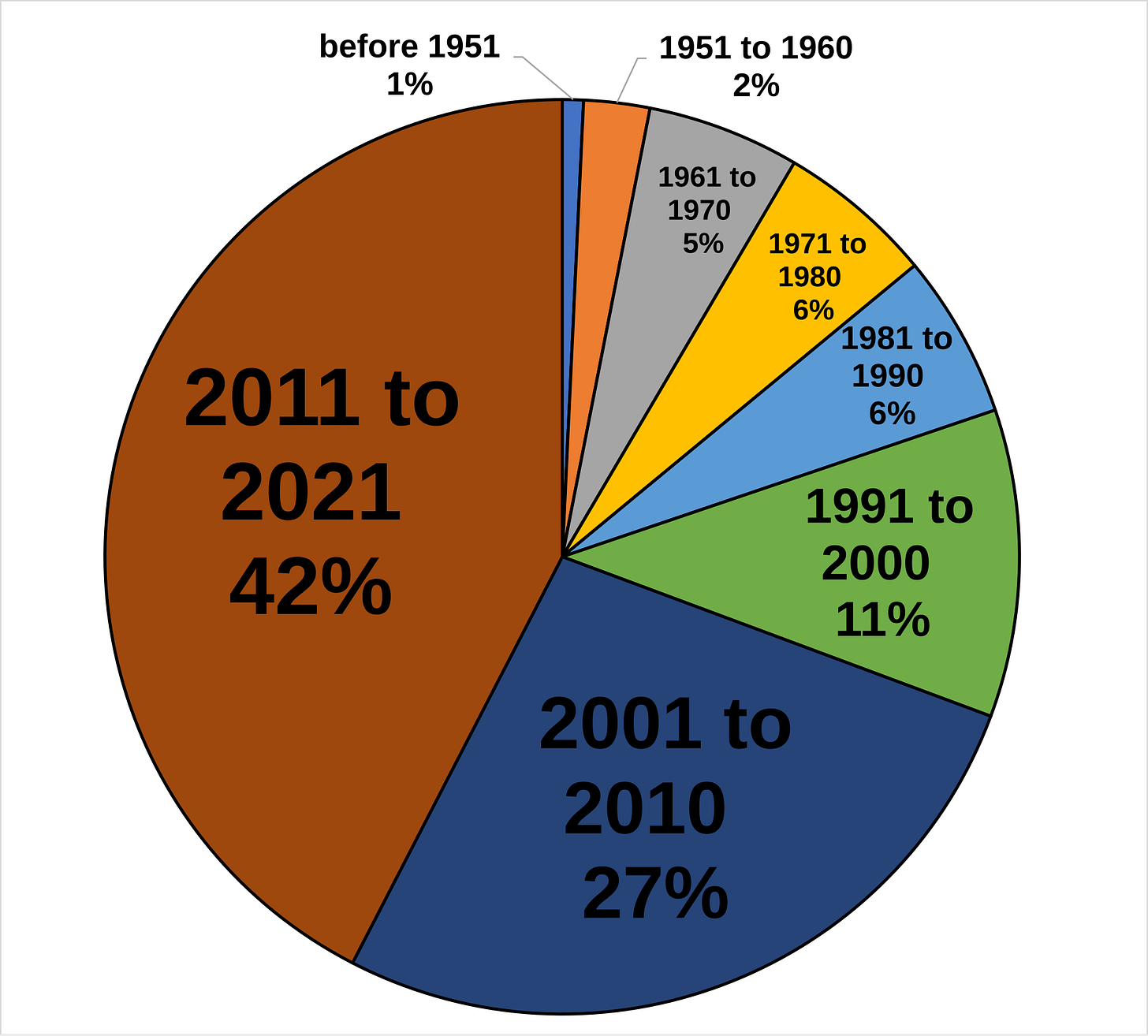
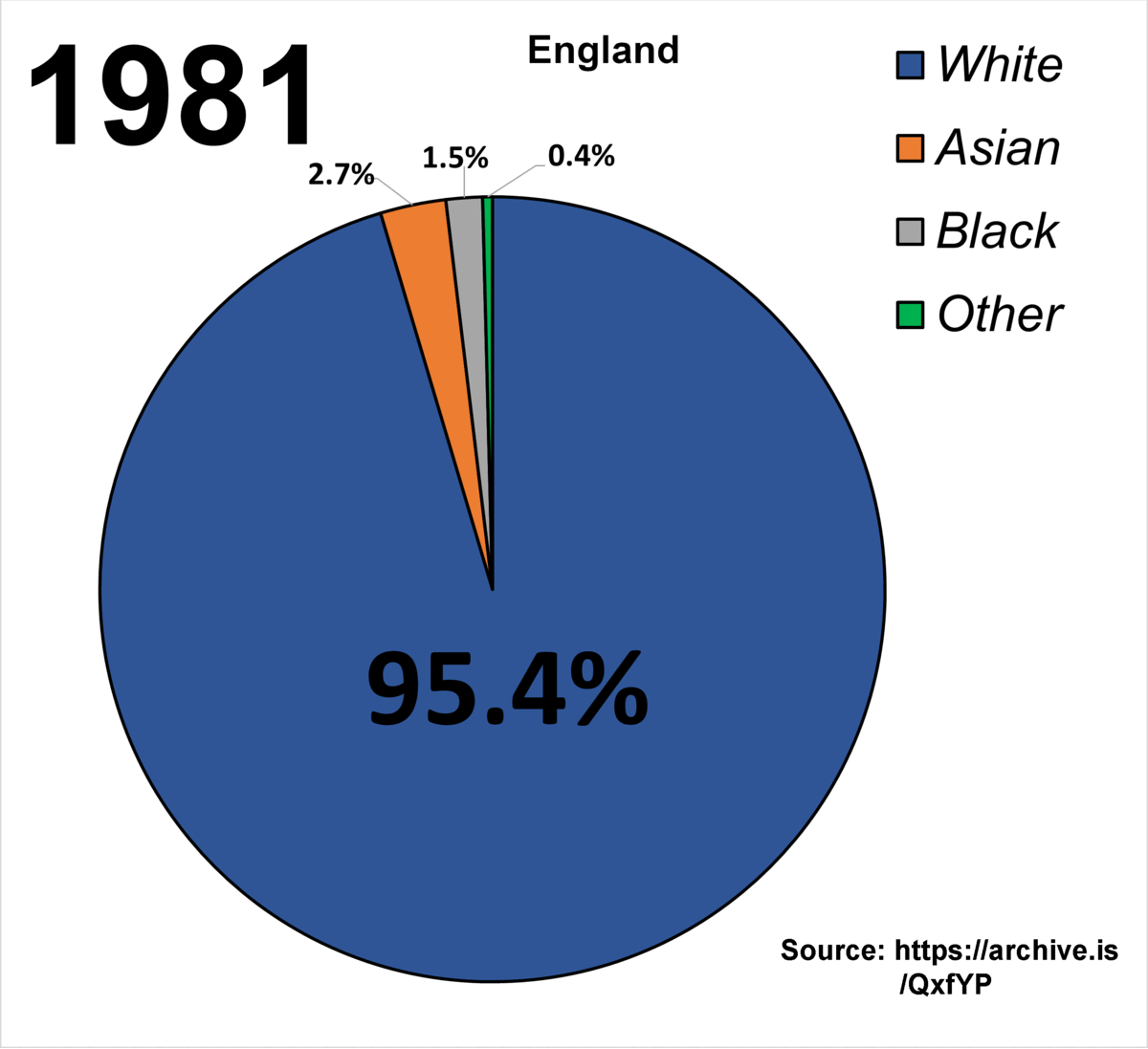
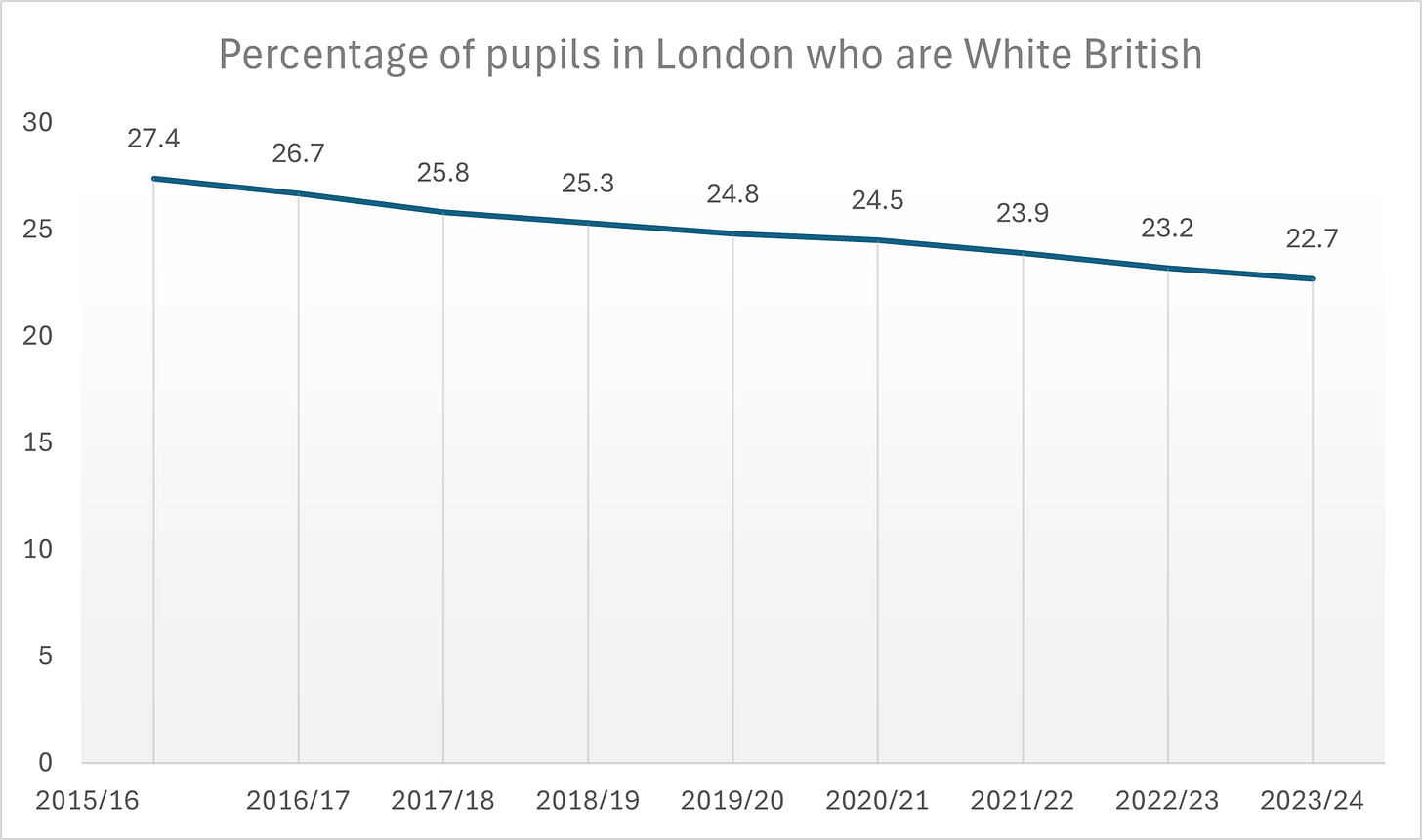
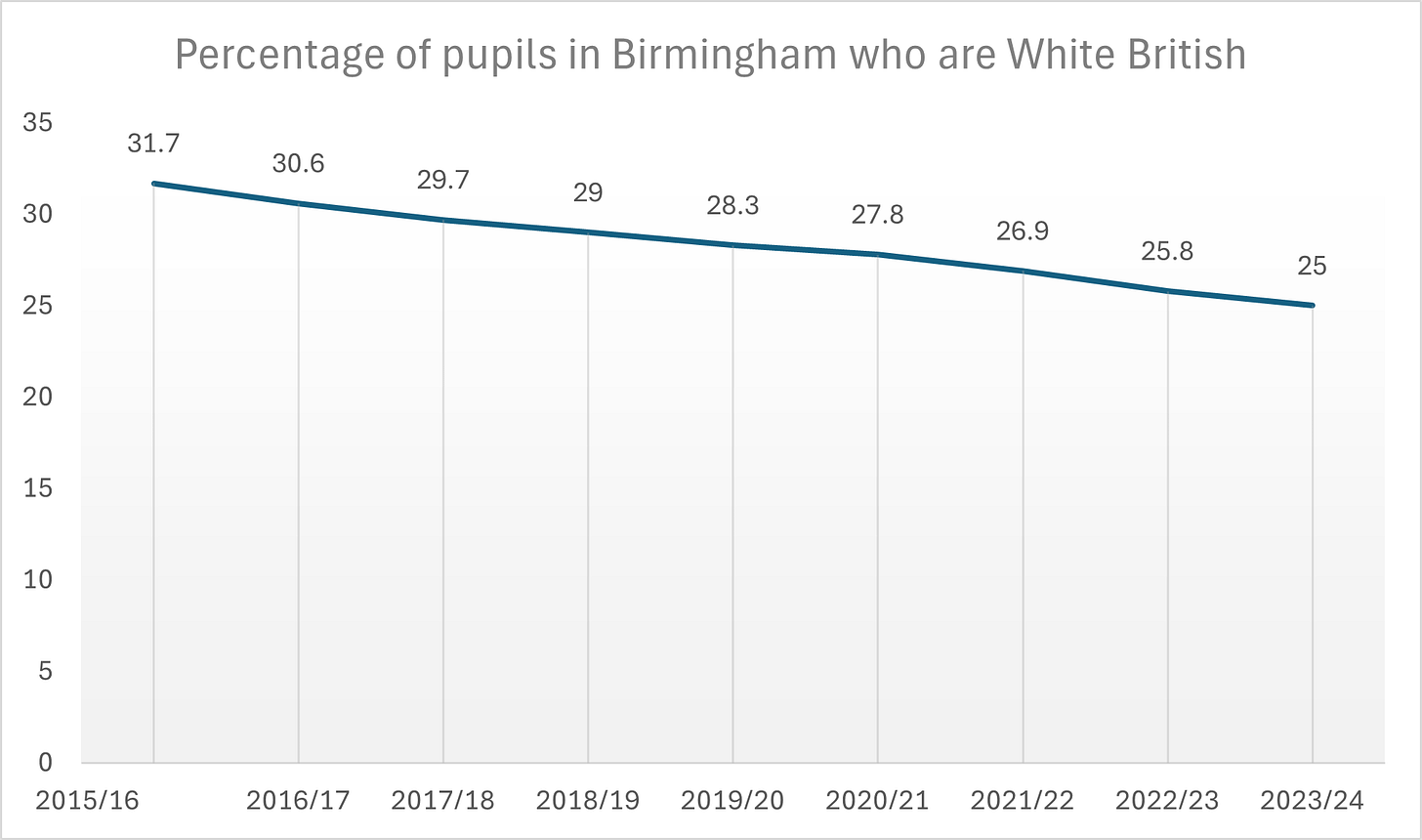
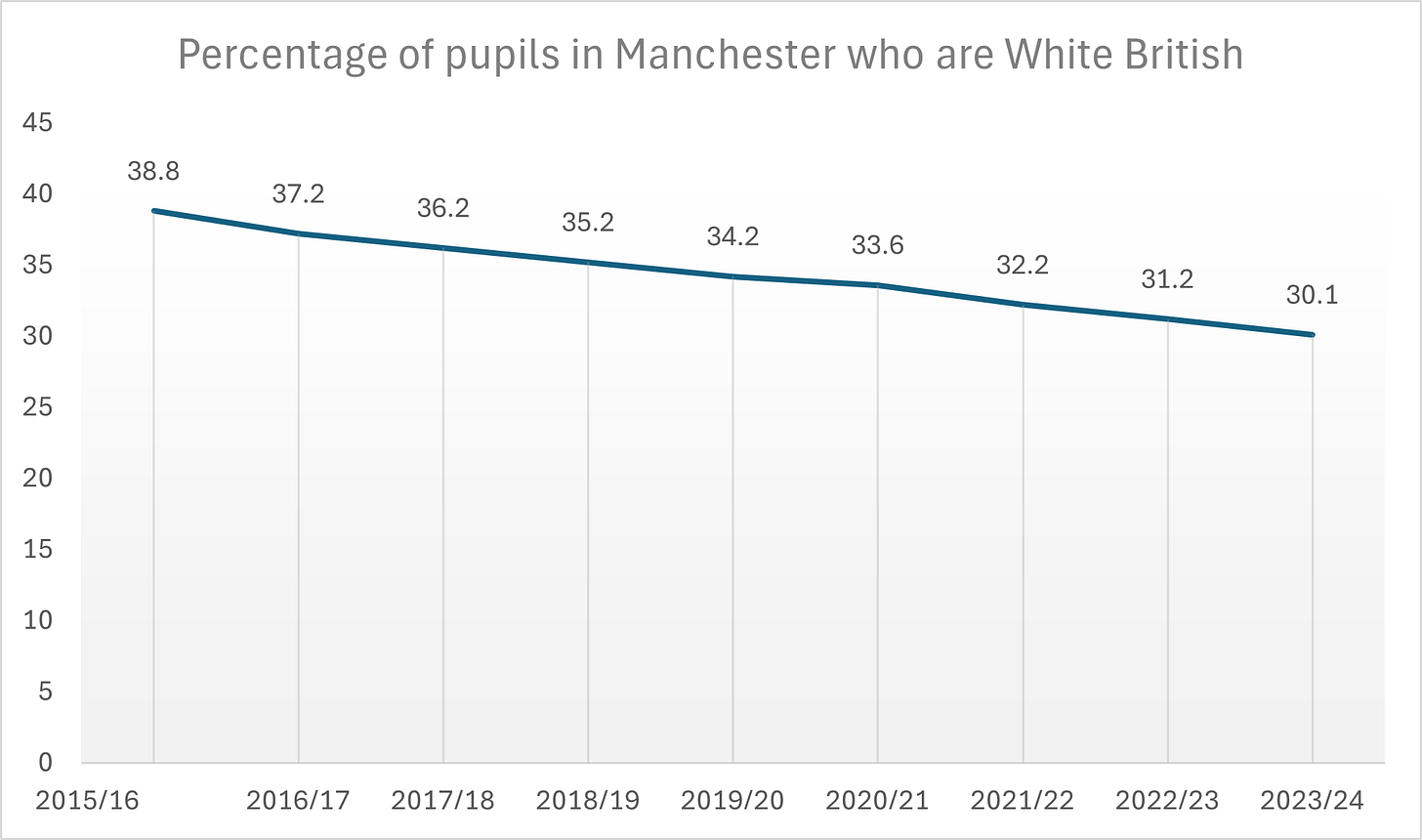
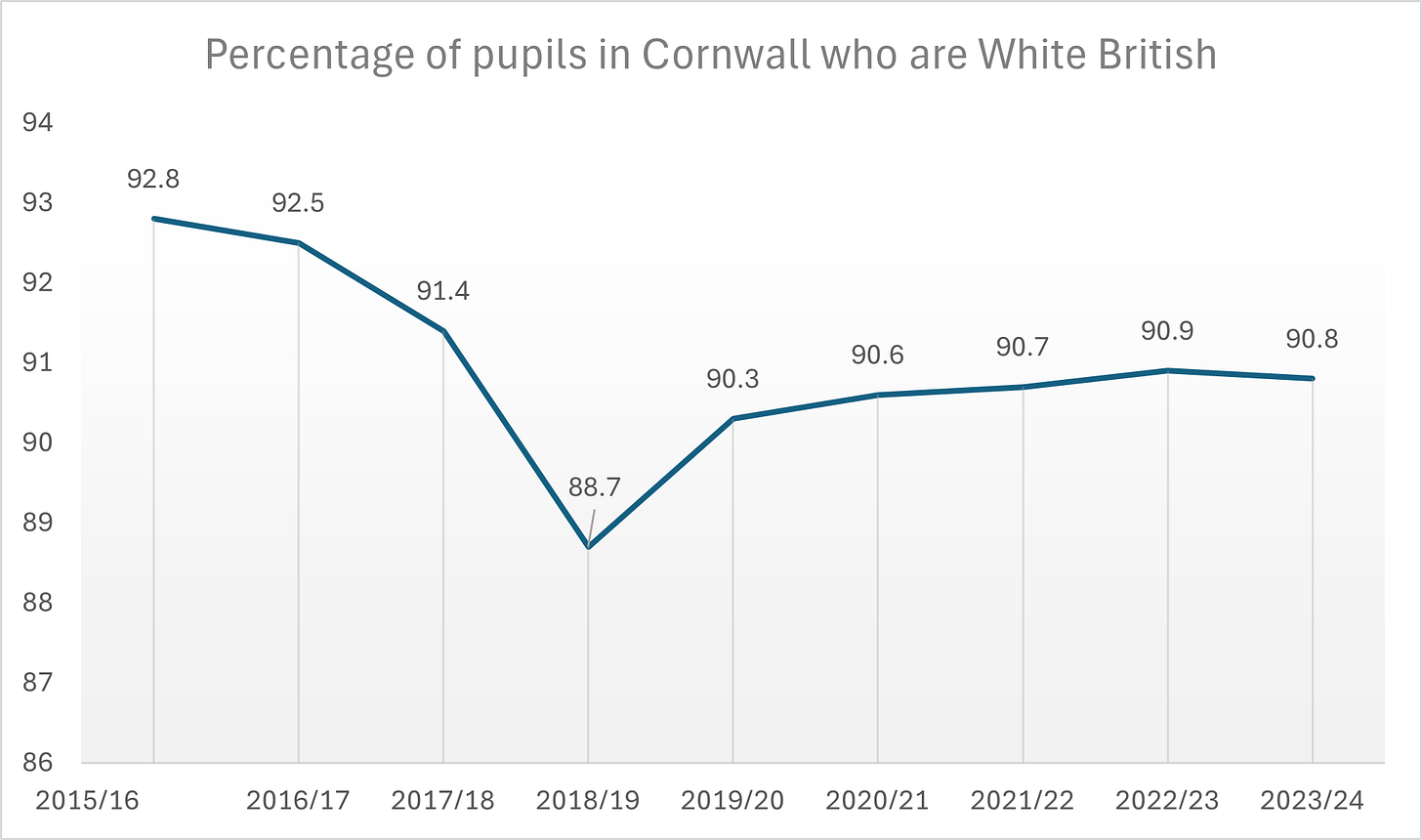
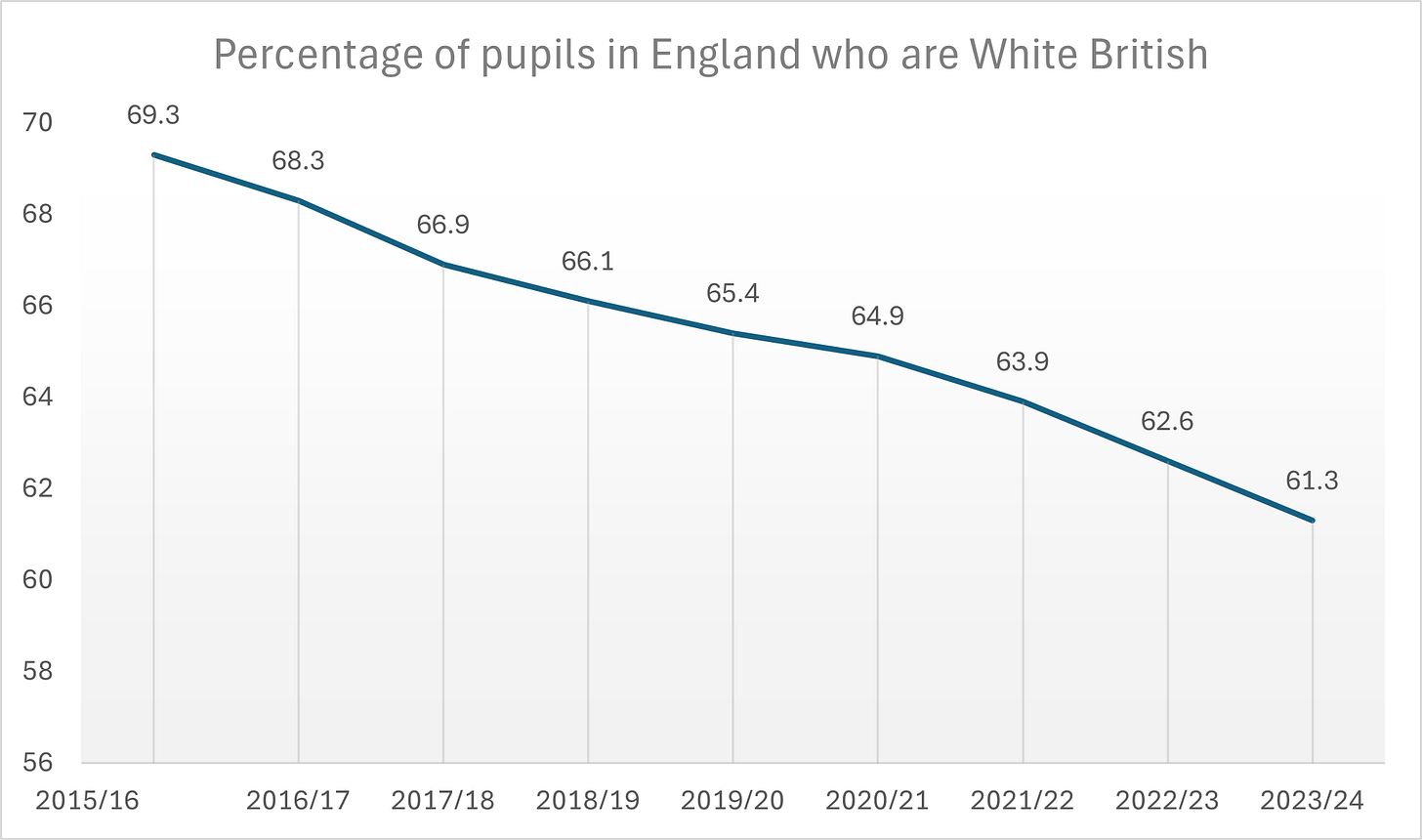
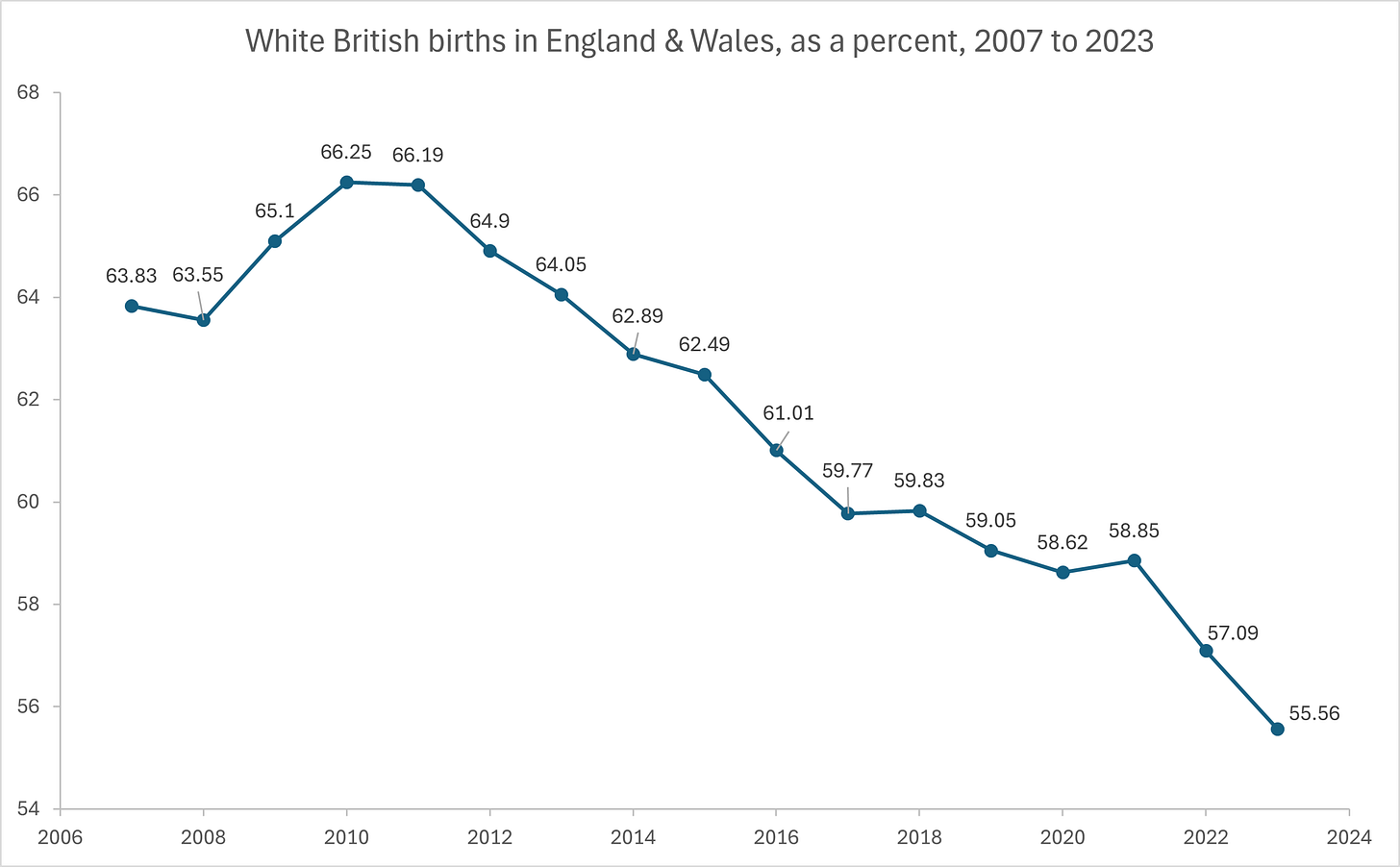

This is *the* issue and nothing else is more important. Demographics are destiny. If our future is minority White British, its not one I'm going to allow my children to grow up in. Either Reform starts to reverse this or I'm moving to Eastern Europe.
Very sad statistics
Racially and religiously segregated neighborhoods in this country are so uncomfortable I try to escape them all the time
Imagine if the whole country turned this way